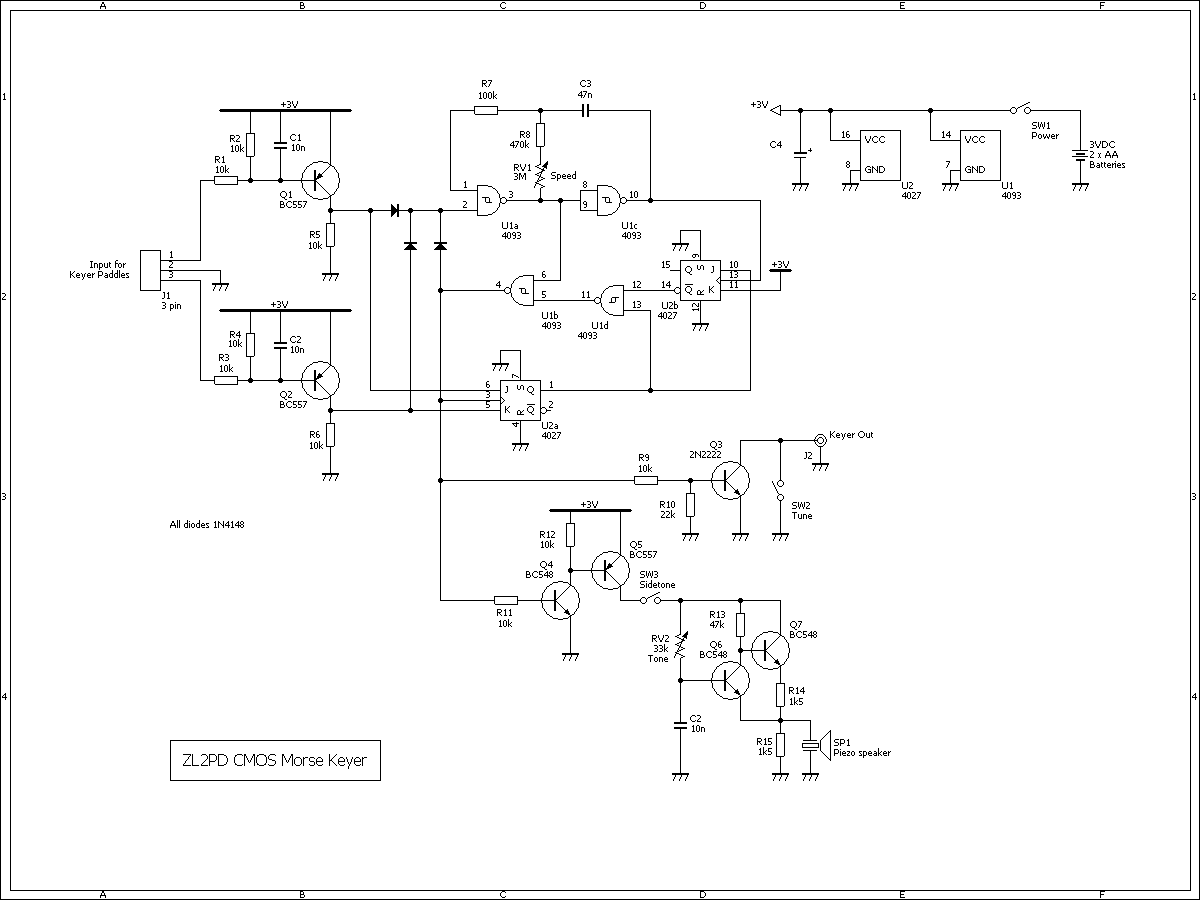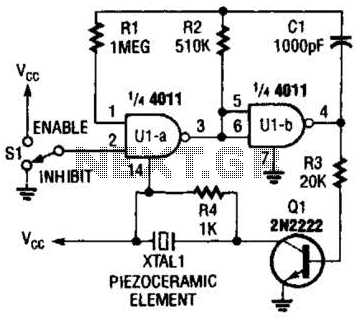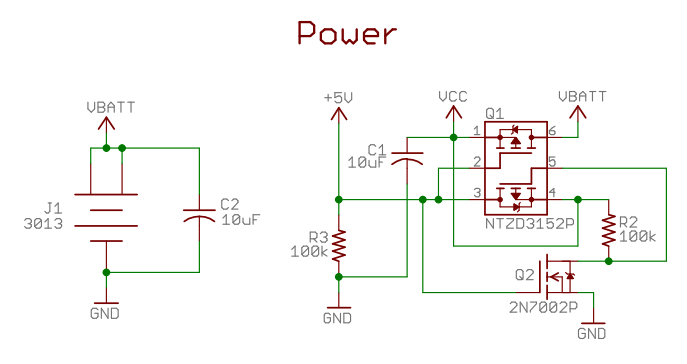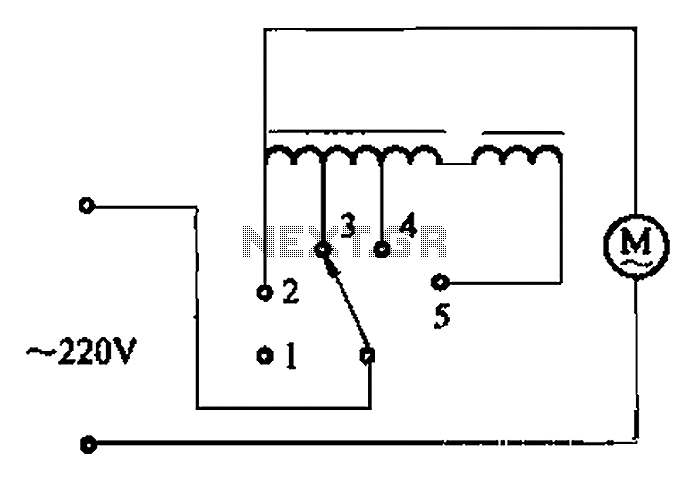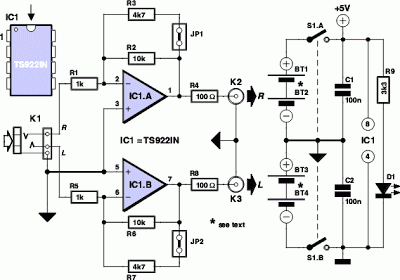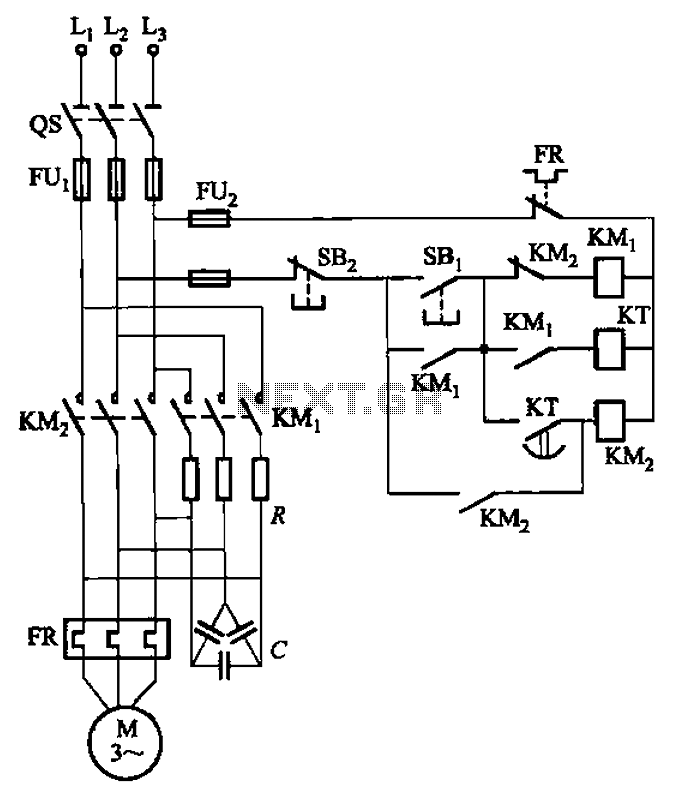
AF2310 radio controlled motor circuit design project
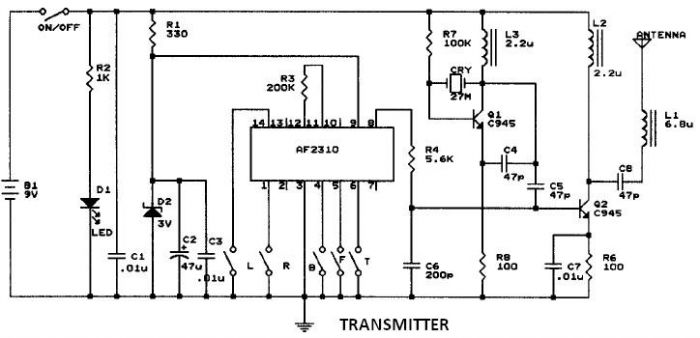
This circuit resembles that of a car radio-controlled toy with seven control functions: forward, forward-left, forward-right, backward, backward-left, backward-right, and stop. Additionally, this radio frequency circuit can be utilized for other electronic circuits that require a simple wireless motor controller. The remote control operates at a frequency of 27.9 MHz and requires a 9-volt power supply. Commands are executed through various electrical contacts that encode a sequence of electrical pulses, with the number of pulses varying based on the command being sent. An electrical circuit tuned to a frequency of 27.9 MHz generates a signal that is transmitted to the antenna when the pulses are active. The antenna converts the electrical energy into radio energy, producing a series of radio energy bursts that travel through the air and are received by the radio receiver in the car. When the car is powered on, the radio receiver continuously monitors the electrical energy from its antenna. The receiver functions as a filter, amplifying energy around 27.9 MHz while blocking energy outside this range. If the remote control transmitter is sending commands, its radio signal will be detected by the receiver and converted back into the original pulse sequence. Decoding circuitry then identifies the commands by measuring the number of received pulses in the sequence. Signals are subsequently sent to the motors to execute the commands. When using strong batteries and in an open area, the range can reach at least 40 feet. Obstacles may attenuate the radio signal's ability to travel through the air and reduce the operational range, though they will not completely obstruct it. In the car, weak batteries can diminish power to the motor and impair the receiver's capacity to filter, amplify, and decode commands from the transmitter. Upon receiving a command to turn left or right, a voltage is applied to the steering motor. Since the front wheels are connected to the steering bar, the car will turn accordingly. To turn in the opposite direction, the voltage to the motor is reversed. The driving motor operates similarly to the steering motor; when a command is received to move forward, a voltage is applied to the driving motor, and this voltage is reversed to move backward.
The circuit utilizes a simple yet effective architecture for controlling the movement of a radio-controlled vehicle. At its core, the system comprises a transmitter and a receiver, with the transmitter generating commands based on user inputs through a control interface. The commands are transmitted as a series of modulated pulses at a precise frequency of 27.9 MHz, which is critical for ensuring reliable communication between the transmitter and receiver.
The receiver is equipped with a bandpass filter specifically tuned to 27.9 MHz, allowing it to isolate the desired signal from background noise. This filtering process is essential for maintaining the integrity of the received commands, particularly in environments with potential interference. Once the signal is received, it is amplified to ensure sufficient strength for processing.
The decoding circuitry within the receiver interprets the sequence of pulses, determining the specific command based on the number of pulses received. This command is then translated into control signals for the driving and steering motors. The driving motor is responsible for propelling the car forward or backward, while the steering motor adjusts the direction based on the commands received.
Power supply considerations are also critical in this design. A 9-volt battery is typically used to power both the transmitter and receiver, and the performance of the motors is directly influenced by the battery's charge level. Strong batteries provide optimal performance, ensuring that the motors receive adequate voltage for effective operation. Conversely, weak batteries can lead to diminished motor performance and reduced operational range, highlighting the importance of maintaining battery health for reliable functionality.
In summary, this radio-controlled circuit is a versatile solution for various applications requiring wireless motor control, leveraging RF communication principles to execute complex movement commands with precision and efficiency. The design's robustness allows for effective operation within a range of conditions, making it suitable for both recreational and educational purposes in electronics and robotics.This circuit is very similar with a car radio controlled toy with seven control functions: forward, forward-left, forward-right, backward, backward-left, backward-right, and stop. Also you can use this radio frequency circuit for some other electronic circuits that require a simple wire less motor controller.
The remote control work`s at a frequen cy of 27. 9 MHz and require a 9 volts power supply. Commands are controlled by different sets of electrical contacts that are used to encode a sequence of electrical pulses; the number of pulses depends on which command is being sent. An electrical circuit that is tuned to a frequency of 27. 9 MHz creates a signal that is sent to the antenna when the pulses are active. The antenna converts the electrical energy into radio energy, creating a stream of radio energy bursts, which travel through the air and are picked up by and understood by the radio receiver in the car.
If the car is turned on then the radio receiver in the car is continuously monitoring the electrical energy from its antenna. The receiver is a filter which is tuned to amplify any energy around 27. 9 MHz and block energy the antenna picks up outside this region. If the Remote Control Transmitter is sending commands then its radio signal will be picked up by the receiver and converted back into the original pulse sequence.
Decoding circuitry then determines which commands were sent by measuring the number of received pulses in the sequence. Signals are then sent to the motors to execute the commands. When operated with strong batteries and in an open area the range will be at least 40 ft. Obstacles will degrade the radio signal`s ability to travel through air and reduce operating range, but will never block it completely.
In the car, weak batteries will reduce power to the Motor and degrade the receiver`s ability to filter, amplify, and decode commands from the Transmitter. When a command is received to turn left or right, a voltage is applied to the Steering Motor Since the Front Wheels are connected to the Steering Bar, the car will turn.
To the turn the other direction, the voltage to the motor is reversed. The Driving Motor works the same as the Steering Motor. When a command is received to go forwards a voltage is applied to the Driving Motor; this voltage is reversed to go backwards. 🔗 External reference
The circuit utilizes a simple yet effective architecture for controlling the movement of a radio-controlled vehicle. At its core, the system comprises a transmitter and a receiver, with the transmitter generating commands based on user inputs through a control interface. The commands are transmitted as a series of modulated pulses at a precise frequency of 27.9 MHz, which is critical for ensuring reliable communication between the transmitter and receiver.
The receiver is equipped with a bandpass filter specifically tuned to 27.9 MHz, allowing it to isolate the desired signal from background noise. This filtering process is essential for maintaining the integrity of the received commands, particularly in environments with potential interference. Once the signal is received, it is amplified to ensure sufficient strength for processing.
The decoding circuitry within the receiver interprets the sequence of pulses, determining the specific command based on the number of pulses received. This command is then translated into control signals for the driving and steering motors. The driving motor is responsible for propelling the car forward or backward, while the steering motor adjusts the direction based on the commands received.
Power supply considerations are also critical in this design. A 9-volt battery is typically used to power both the transmitter and receiver, and the performance of the motors is directly influenced by the battery's charge level. Strong batteries provide optimal performance, ensuring that the motors receive adequate voltage for effective operation. Conversely, weak batteries can lead to diminished motor performance and reduced operational range, highlighting the importance of maintaining battery health for reliable functionality.
In summary, this radio-controlled circuit is a versatile solution for various applications requiring wireless motor control, leveraging RF communication principles to execute complex movement commands with precision and efficiency. The design's robustness allows for effective operation within a range of conditions, making it suitable for both recreational and educational purposes in electronics and robotics.This circuit is very similar with a car radio controlled toy with seven control functions: forward, forward-left, forward-right, backward, backward-left, backward-right, and stop. Also you can use this radio frequency circuit for some other electronic circuits that require a simple wire less motor controller.
The remote control work`s at a frequen cy of 27. 9 MHz and require a 9 volts power supply. Commands are controlled by different sets of electrical contacts that are used to encode a sequence of electrical pulses; the number of pulses depends on which command is being sent. An electrical circuit that is tuned to a frequency of 27. 9 MHz creates a signal that is sent to the antenna when the pulses are active. The antenna converts the electrical energy into radio energy, creating a stream of radio energy bursts, which travel through the air and are picked up by and understood by the radio receiver in the car.
If the car is turned on then the radio receiver in the car is continuously monitoring the electrical energy from its antenna. The receiver is a filter which is tuned to amplify any energy around 27. 9 MHz and block energy the antenna picks up outside this region. If the Remote Control Transmitter is sending commands then its radio signal will be picked up by the receiver and converted back into the original pulse sequence.
Decoding circuitry then determines which commands were sent by measuring the number of received pulses in the sequence. Signals are then sent to the motors to execute the commands. When operated with strong batteries and in an open area the range will be at least 40 ft. Obstacles will degrade the radio signal`s ability to travel through air and reduce operating range, but will never block it completely.
In the car, weak batteries will reduce power to the Motor and degrade the receiver`s ability to filter, amplify, and decode commands from the Transmitter. When a command is received to turn left or right, a voltage is applied to the Steering Motor Since the Front Wheels are connected to the Steering Bar, the car will turn.
To the turn the other direction, the voltage to the motor is reversed. The Driving Motor works the same as the Steering Motor. When a command is received to go forwards a voltage is applied to the Driving Motor; this voltage is reversed to go backwards. 🔗 External reference
